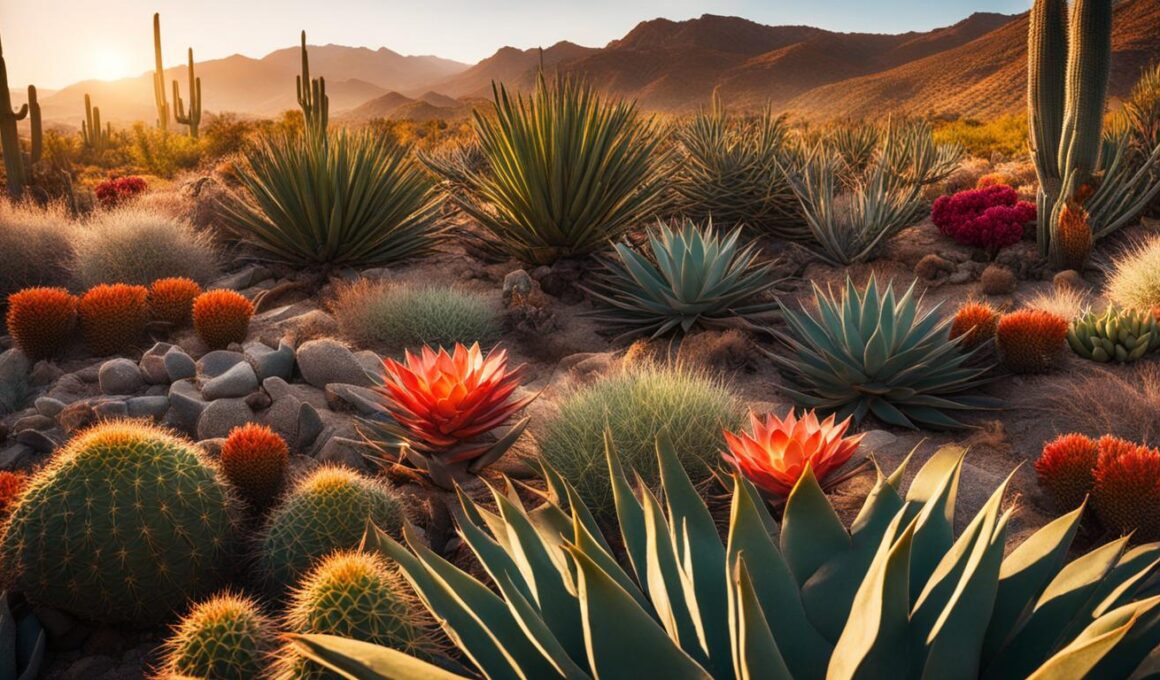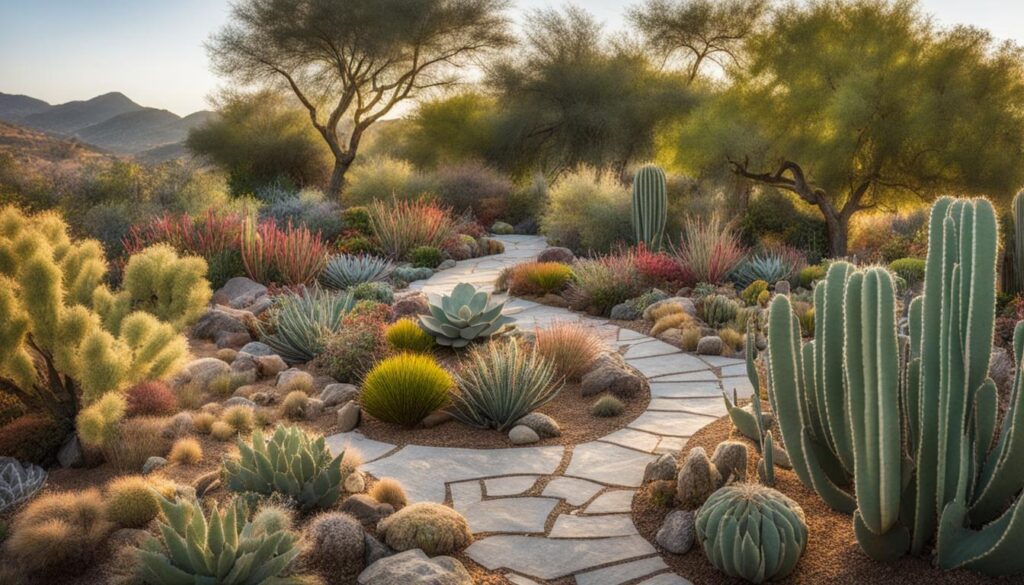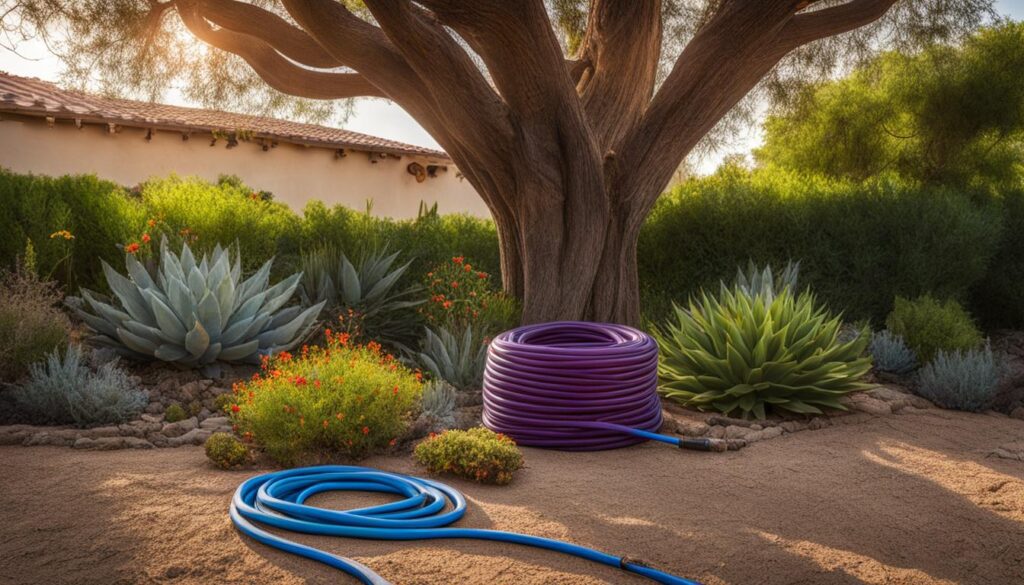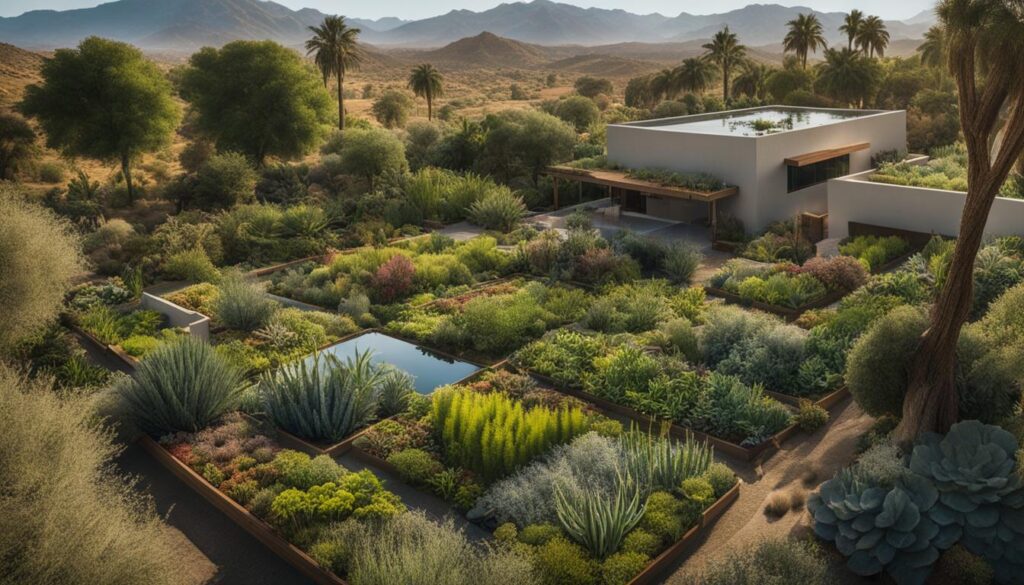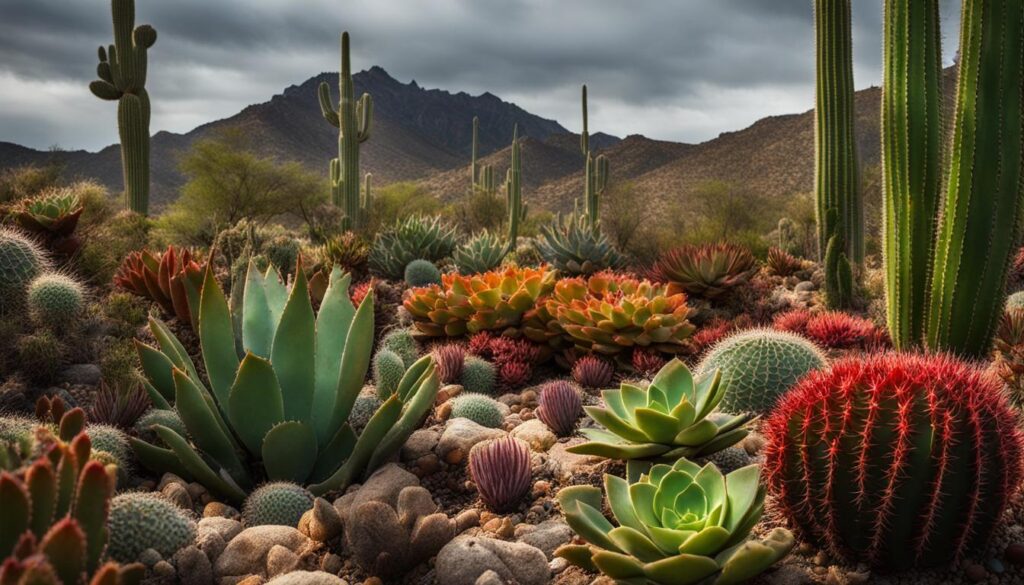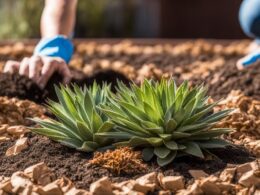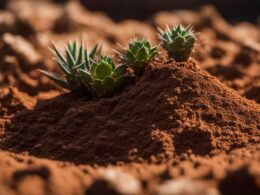Are you ready to transform your garden into a sustainable oasis that thrives even in dry climates? By mastering the art of sustainable gardening and incorporating drought-resistant species, you can create a vibrant and resilient landscape that conserves water and supports the environment.
Drought-tolerant plants possess unique adaptations that allow them to survive and thrive in dry spells, making them the perfect choice for water-wise gardening. From deep root systems to silver foliage and succulent stems, these plants have evolved to make the most of limited water resources. Understanding their characteristics is key to creating a sustainable garden that flourishes even during drought conditions.
Join us as we explore the world of sustainable gardening and discover how to incorporate drought-resistant species into your landscape. From designing a drought-tolerant garden to prioritizing water use and embracing eco-friendly methods, you’ll gain the knowledge and insights needed to become a master of sustainable gardening.
Key Takeaways:
- Sustainable gardening involves incorporating drought-resistant species into your landscape.
- Drought-tolerant plants have unique adaptations that allow them to survive in dry conditions.
- Understanding plant hardiness zones and Earth-Kind ratings can help you select the right plants for your climate.
- Watering strategies, such as using soaker hoses and mulching, can help conserve water in a drought-tolerant garden.
- Prioritizing water use is important during drought conditions, focusing on newly planted trees and shrubs, as well as flowering perennials and vegetables.
Designing a Drought-Tolerant Garden
When it comes to creating a drought-tolerant garden, designing with water-wise landscaping techniques is key. By implementing xeriscaping principles and selecting the right plants, you can create a beautiful and sustainable garden that thrives in dry climates.
Consider Plant Hardiness Zones and Earth-Kind Ratings
Before diving into the design process, it’s important to consider the plant hardiness zones and Earth-Kind ratings for your area. Plant hardiness zones provide valuable information about the climate suitability for different plants, ensuring that you choose species that can withstand the conditions of your region.
Earth-Kind ratings, on the other hand, evaluate a plant’s performance in heat tolerance, water requirements, pest resistance, and fertilizer tolerance. By selecting plants with high Earth-Kind ratings, you can ensure that they are well-suited to your climate and have the resilience to thrive in drought conditions.
Create a Resilient and Water-Wise Layout
When designing your drought-tolerant garden, consider the layout and arrangement of plants to maximize water efficiency. Grouping plants with similar water needs together can help you create watering zones and avoid wasting water. Additionally, incorporating hardscaping elements such as paths and mulched areas can reduce the overall water requirements of your garden.
Design your garden with drought-tolerant species that require minimal irrigation and prioritize water efficiency. By combining native plants, low-water perennials, and succulents, you can create a visually stunning landscape that conserves water.
Table: Drought-Tolerant Plants for Your Garden
| Plant | Water Needs | Sun Exposure | Height | Blooming Season |
|---|---|---|---|---|
| Lantana | Low | Full sun | 3-6 ft | Spring to fall |
| Salvia | Low to moderate | Full sun | 1-4 ft | Spring to fall |
| Cactus | Very low | Full sun | Varies | Varies |
| Shrimp Plant | Low to moderate | Partial shade to full sun | 2-4 ft | Year-round |
| Turk’s Cap | Low to moderate | Partial shade to full sun | 3-6 ft | Summer to fall |
| Native Species | Varies | Varies | Varies | Varies |
Note: The water needs, sun exposure, height, and blooming season may vary depending on the specific variety and region. Consult local gardening resources for more accurate information.
By designing a drought-tolerant garden using water-wise landscaping techniques and selecting the right plants, you can create a sustainable and beautiful outdoor space that conserves water while adding aesthetic value to your home.
Choosing Drought-Tolerant Plants
When creating a drought-tolerant garden, it is essential to choose the right plants that can thrive in low-water conditions. Drought-tolerant plants have unique adaptations that allow them to withstand dry spells and require minimal maintenance. Incorporating these plants into your garden can help conserve water and create a beautiful, sustainable landscape.
Native plants are an excellent choice for low-water gardening. They are naturally adapted to the local climate and require less water once established. Some popular native drought-tolerant plants include lantana, salvias, and Turk’s cap. These plants not only add color and texture to your garden but also attract beneficial insects and wildlife.
Another option is to consider succulents and cacti, which have specialized structures that store water, such as fleshy leaves and stems. These plants are well-suited for arid climates and can withstand long periods without water. Popular drought-tolerant succulents include agave, echeveria, and aloe.
Table: Drought-Tolerant Plants
| Plant | Type | Water Requirements |
|---|---|---|
| Lantana | Shrub | Low |
| Salvias | Perennial | Low |
| Turk’s Cap | Shrub | Low |
| Agave | Succulent | Very low |
| Echeveria | Succulent | Very low |
| Aloe | Succulent | Very low |
Choose plants that are well-adapted to your specific climate and soil conditions. Consider their water requirements and choose plants that have low to moderate water needs. By selecting the right drought-tolerant plants, you can create a beautiful and sustainable garden that requires minimal water.
In addition to selecting drought-tolerant plants, it is important to prepare your soil properly. Amending the soil with organic matter, such as compost, can improve its water-holding capacity and reduce the need for frequent watering. Adding a layer of mulch around your plants can also help retain moisture and suppress weed growth.
Remember that even drought-tolerant plants need some water, especially during their establishment period. Once established, these plants can thrive with minimal supplemental watering. By choosing the right plants for your garden and implementing proper watering techniques, you can create a low-water, sustainable landscape that is both beautiful and environmentally friendly.
Watering Strategies for Drought-Tolerant Gardens
Proper watering strategies are crucial for maintaining the health and vitality of drought-tolerant gardens. By adopting efficient watering practices, you can minimize water waste and ensure that your plants receive the hydration they need to thrive.
Watering Efficiency
When watering your drought-tolerant garden, it’s essential to focus on efficiency. Rather than frequent shallow watering, which promotes shallow root growth and evaporation, aim for deep, infrequent watering sessions. This encourages plants to establish deep root systems, enabling them to access moisture stored deeper in the soil.
One effective technique for efficient watering is to use soaker hoses or drip-irrigation tubing. These methods deliver water directly to the plant’s roots, minimizing loss due to evaporation and ensuring that every drop counts. Additionally, consider utilizing mulch around your plants. Mulching helps conserve soil moisture by reducing evaporation and suppressing weed growth, which can compete with your plants for water.
Gray Water Irrigation
Another eco-friendly option for watering your drought-tolerant garden is to use gray water. Gray water is wastewater from sources such as sinks, showers, and laundry machines that can be safely reused for irrigation. By capturing and diverting gray water, you can reduce reliance on freshwater sources and make more sustainable use of available resources.
Before utilizing gray water, it’s crucial to follow guidelines and regulations in your area to ensure proper handling and prevent contamination. Remember to avoid using gray water on edible parts of plants that may come into contact with the water directly.
Table: Comparative Watering Strategies for Drought-Tolerant Gardens
| Watering Strategy | Advantages | Considerations |
|---|---|---|
| Deep, infrequent watering | Promotes deep root growth and reduces water loss through evaporation. | Requires careful monitoring to avoid overwatering and underwatering. |
| Soaker hoses or drip-irrigation tubing | Delivers water directly to the plant’s roots, minimizing evaporation and ensuring efficient water use. | Requires proper installation and maintenance to prevent clogging. |
| Gray water irrigation | Allows for the reuse of wastewater, reducing reliance on freshwater resources. | Requires compliance with local regulations to ensure safe and proper use. |
| Mulching | Helps conserve soil moisture by reducing evaporation and suppressing weed growth. | Requires regular replenishment to maintain effectiveness. |
By implementing these watering strategies and using resources efficiently, you can maintain a flourishing drought-tolerant garden while contributing to water conservation efforts.
Prioritizing Water Use in Drought Conditions
During drought conditions, it is crucial to prioritize water use in your garden to ensure the survival and health of your plants. By focusing your watering efforts on specific areas, you can make the most efficient use of this precious resource. Here are some key considerations for water prioritization:
Prioritize Newly Planted Trees and Shrubs
When establishing new trees and shrubs, it is important to provide them with regular watering until their roots become established. These young plants are more vulnerable to drought stress and require additional moisture to develop strong root systems. Prioritize watering these newly planted trees and shrubs to give them the best chance of survival.
Pay Attention to Perennial Flowers and Vegetables
Perennial flowers and vegetables, especially those in their flowering and fruiting stages, may also require additional watering during drought conditions. As they actively produce blooms and develop fruits, these plants have higher water requirements to support their growth and productivity. Monitor their moisture levels and prioritize watering these plants to ensure optimal yields.
Divide Your Garden into Watering Zones
Dividing your garden into watering zones can help you prioritize water distribution based on the specific needs of different plant groups. For example, you can create separate zones for fruit trees, vegetables, ornamental flowers, and lawns. This allows you to allocate water resources efficiently, providing targeted irrigation where it is most needed.
By prioritizing water use in drought conditions and focusing on areas such as newly planted trees and shrubs, perennial flowers, and vegetables, you can optimize water efficiency while maintaining a healthy and thriving garden.
Embracing Sustainable Gardening Methods
Your commitment to sustainable gardening not only promotes an eco-friendly approach but also contributes to biodiversity. By implementing practices that conserve water and support the natural environment, you can create a thriving and resilient garden. Incorporating native species, efficient irrigation techniques, and mulching are just a few ways to embrace sustainable gardening methods.
Planting Native Species
One of the foundations of sustainable gardening is planting native species that are well-adapted to the local climate. These plants have evolved to thrive in the specific conditions of your region, making them more resilient to drought and other environmental challenges. By choosing native species, you can reduce water usage and support local biodiversity.
Efficient Irrigation Techniques
Watering your garden efficiently is essential for sustainable gardening. Consider using drip irrigation or soaker hoses to deliver water directly to the plant roots, minimizing wastage through evaporation or runoff. Additionally, installing a rainwater harvesting system allows you to utilize natural rainfall to water your garden, reducing reliance on municipal water sources.
“Sustainable gardening methods not only save water but also contribute to the long-term health and vitality of your garden.”
Mulching for Water Conservation
Mulching is an effective technique for conserving soil moisture and reducing water evaporation. By applying a layer of organic mulch, such as wood chips or straw, around your plants, you can help regulate soil temperature, suppress weed growth, and retain moisture. Mulch also enriches the soil as it breaks down over time, promoting a healthy ecosystem for your plants.
To summarize, embracing sustainable gardening methods involves planting native species, using efficient irrigation techniques, and implementing mulching practices. These strategies not only conserve water but also support biodiversity, making them essential components of a eco-friendly approach to gardening.
Understanding Plant Zones and Earth-Kind Ratings
When it comes to choosing plants for your garden, understanding plant zones and Earth-Kind ratings is crucial. Plant hardiness zones provide valuable information about the climate suitability for different plants, helping you select species that can thrive in your specific climate conditions. Each zone represents a specific range of temperatures and weather patterns that plants can tolerate. By knowing your plant zone, you can ensure that the plants you choose will have the best chance of success in your garden.
Earth-Kind ratings, on the other hand, evaluate a plant’s performance in various aspects like heat tolerance, water requirements, pest resistance, and fertilizer tolerance. These ratings provide insights into a plant’s ability to withstand and thrive in challenging conditions, such as drought. By considering both plant zones and Earth-Kind ratings, you can make informed choices and select plants that are well-suited to your climate and resilient to drought conditions.
Table: Plant Hardiness Zones
| Zone | Temperature Range (°F) | Climate Characteristics |
|---|---|---|
| Zone 1 | -60 to -50 | Extreme cold |
| Zone 2 | -50 to -40 | Very cold |
| Zone 3 | -40 to -30 | Cold |
| Zone 4 | -30 to -20 | Moderate cold |
| Zone 5 | -20 to -10 | Cool |
| Zone 6 | -10 to 0 | Mild cool |
| Zone 7 | 0 to 10 | Moderate |
| Zone 8 | 10 to 20 | Mild warm |
| Zone 9 | 20 to 30 | Warm |
| Zone 10 | 30 to 40 | Hot |
| Zone 11 | Above 40 | Extreme heat |
By understanding plant zones and Earth-Kind ratings, you can confidently select plants that are suitable for your climate and have the characteristics needed to thrive in dry conditions. This knowledge will enable you to create a beautiful and resilient garden that can withstand the challenges of drought and conserve water while still providing a vibrant and lush landscape.
Next, we will explore some specific drought-tolerant plant options that are ideal for your garden. These plants are not only low-maintenance but also water-wise, making them perfect for conserving water while still enjoying a beautiful landscape. Let’s dive in!
Drought-Tolerant Plants for Your Garden
If you’re looking to create a low-maintenance, water-wise garden, incorporating drought-tolerant plants is a great choice. These plants have adaptations that allow them to thrive in dry climates, making them perfect for conserving water and creating a beautiful landscape. Here are some excellent options to consider:
Lantana
Lantana is a colorful and hardy plant that is known for its ability to withstand drought conditions. With its vibrant flowers and long blooming season, lantana adds a pop of color to any garden. It is also a favorite of pollinators, attracting butterflies and hummingbirds.
Salvias
Salvias are a diverse group of plants that come in various colors and sizes. They are known for their striking flowers and aromatic foliage. Salvias are drought-tolerant and require little maintenance, making them a great addition to any water-wise garden.
Cactus
For a truly low-maintenance option, consider adding cactus to your garden. Cacti are well-adapted to desert environments and can survive with minimal water. They come in a wide range of shapes and sizes, adding architectural interest to your landscape.
Shrimp Plant
The shrimp plant (Justicia brandegeeana) is a unique and eye-catching plant that is drought-tolerant and easy to grow. Its bright red bracts resemble shrimp, giving the plant its name. The shrimp plant attracts butterflies and hummingbirds, making it a delightful addition to any garden.
Turk’s Cap
Turk’s cap (Malvaviscus arboreus) is a native plant that is well-suited for dry climates. It has showy red flowers that attract hummingbirds and butterflies. Turk’s cap is also known for its tolerance to heat and drought, making it an ideal choice for a water-wise garden.
Native Species
Incorporating native species into your garden is another great way to create a drought-tolerant landscape. Native plants are naturally adapted to the local climate and require less water compared to non-native species. They also support biodiversity and provide habitat for native wildlife.
By choosing drought-tolerant plants like lantana, salvias, cactus, shrimp plant, Turk’s cap, and native species, you can create a stunning and water-wise garden. These plants not only conserve water but also require minimal maintenance, allowing you to enjoy a beautiful landscape with ease.
Conclusion
Mastering the art of sustainable gardening with drought-resistant species is a crucial step towards conserving water and creating a resilient and vibrant landscape. By understanding the unique characteristics of these plants, you can develop a garden that thrives in dry climates while minimizing water consumption.
Implementing water-saving strategies such as efficient irrigation and mulching can further enhance your sustainable gardening efforts, allowing you to make the most of every drop. Additionally, prioritizing water use for newly planted trees and shrubs, as well as flowering and fruiting plants, ensures their healthy growth and survival during drought conditions.
Embracing sustainable gardening methods not only benefits your landscape but also contributes to environmental conservation. By choosing native species that are naturally adapted to your local climate and supporting biodiversity, you create an eco-friendly approach that minimizes water usage and promotes a healthier ecosystem.
FAQ
What are some drought-tolerant plant adaptations?
Drought-tolerant plants have adaptations such as deep root systems, silver or grey foliage, fuzzy or velvety leaves, succulent stems or leaves, and waxy coatings on leaves.
How can I design a drought-tolerant garden?
When designing a drought-tolerant garden, consider plant hardiness zones and Earth-Kind ratings to select plants that are compatible with your climate and have high performance in heat tolerance, water requirements, pest resistance, and fertilizer tolerance.
What are some drought-resistant plant options?
Lantana, salvias, cactus, shrimp plant, Turk’s cap, and native species are all excellent choices for a drought-tolerant garden.
How can I conserve water in a drought-tolerant garden?
To conserve water, water deeply and infrequently using soaker hoses or drip-irrigation tubing, consider using gray water for irrigation, and use mulch to conserve soil moisture and suppress weed growth.
How should I prioritize water use during drought conditions?
Newly planted trees and shrubs should receive regular watering until their roots are established, and perennial flowers and vegetables in their flowering and fruiting stages may require additional watering.
What are some sustainable gardening methods for drought conditions?
Sustainable gardening methods include planting native species, implementing water-saving techniques like efficient irrigation and mulching, and prioritizing biodiversity and environmental conservation.
What are plant zones and Earth-Kind ratings?
Plant hardiness zones provide information about climate suitability for different plants, while Earth-Kind ratings evaluate a plant’s performance in various factors like heat tolerance, water requirements, pest resistance, and fertilizer tolerance.
What are some drought-tolerant plants I can use for my garden?
Lantana, salvias, cactus, shrimp plant, Turk’s cap, and native species are all excellent choices for a drought-tolerant garden, as they have adaptations to thrive in dry climates and require minimal maintenance.
How can I master sustainable gardening with drought-resistant species?
By understanding the characteristics of drought-tolerant plants, implementing water-saving strategies, prioritizing water use, and embracing sustainable gardening methods, you can create a resilient and vibrant landscape while conserving water and contributing to environmental conservation.





